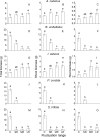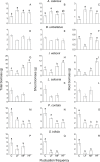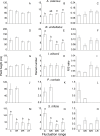Growth responses of eight wetland species to water level fluctuation with different ranges and frequencies
- PMID: 31344145
- PMCID: PMC6657884
- DOI: 10.1371/journal.pone.0220231
Growth responses of eight wetland species to water level fluctuation with different ranges and frequencies
Abstract
Fluctuation range and frequency are two important components of water level fluctuation, but their effects on wetland plants have not been evaluated separately. We subjected eight wetland species to a control treatment with static water level and fluctuation treatments with different ranges or frequencies to examine their effects on plant growth. Acorus calamus, Butomus umbellatus and Iris wilsonii showed high survival rates in all treatments with various fluctuation ranges and frequencies. Their survival rates were higher at the medium fluctuation frequency than at the low and high frequencies, suggesting beneficial effects of the medium frequency. In the experiment comparing the fluctuation ranges, A. calamus and I. wilsonii could maintain the capacity for asexual propagation and accumulate higher biomass compared with the control plants, while biomass of the other six species dramatically decreased. In the experiment comparing fluctuation frequency, species with relatively high survival rates (≥ 50%) maintained or increased the capacity of asexual propagation, and A. calamus and I. wilsonii allocated relatively more biomass to roots, which may enhance plant growth and survival. In contrast, these species did not show increased biomass allocation to shoots in response to both fluctuation range and frequency, presumably because shoots are prone to mechanical damage caused by streaming floodwater. Taken together, biomass accumulation in roots rather than in shoots and the ability to asexually propagate are important for the survival of these species during water fluctuation.
Conflict of interest statement
The authors have declared that no competing interests exist.
Figures





Similar articles
-
[Influence of perennial flooding and drought on growth restoration of Acorus calamus in water-level-fluctuation zone of the Three Gorges Reservoir].Huan Jing Ke Xue. 2012 Aug;33(8):2628-33. Huan Jing Ke Xue. 2012. PMID: 23213883 Chinese.
-
Effects of perchlorate on growth of four wetland plants and its accumulation in plant tissues.Environ Sci Pollut Res Int. 2013 Oct;20(10):7301-8. doi: 10.1007/s11356-013-1744-4. Epub 2013 May 15. Environ Sci Pollut Res Int. 2013. PMID: 23673920
-
[Effect of Biochar on Root Morphological Characteristics of Wetland Plants and Purification Capacity of Constructed Wetland].Huan Jing Ke Xue. 2018 Jul 8;39(7):3187-3193. doi: 10.13227/j.hjkx.201712072. Huan Jing Ke Xue. 2018. PMID: 29962142 Chinese.
-
The effects of polypropylene microplastics on the removal of nitrogen and phosphorus from water by Acorus calamus, Iris tectorum and functional microorganisms.Chemosphere. 2024 Sep;364:143153. doi: 10.1016/j.chemosphere.2024.143153. Epub 2024 Aug 27. Chemosphere. 2024. PMID: 39197682
-
Rising sea level, temperature, and precipitation impact plant and ecosystem responses to elevated CO2 on a Chesapeake Bay wetland: review of a 28-year study.Glob Chang Biol. 2014 Nov;20(11):3329-43. doi: 10.1111/gcb.12631. Epub 2014 Jun 11. Glob Chang Biol. 2014. PMID: 24820033 Review.
Cited by
-
Ecological adaptability and population growth tolerance characteristics of Carex cinerascens in response to water level changes in Poyang Lake, China.Sci Rep. 2021 Mar 1;11(1):4887. doi: 10.1038/s41598-021-84282-x. Sci Rep. 2021. PMID: 33649457 Free PMC article.
References
-
- Raulings EJ, Morris K, Roache MC, Boon PI. The importance of water regimes operating at small spatial scales for the diversity and structure of wetland vegetation. Freshwater Biol. 2010; 55: 701–715. 10.1111/j.1365-2427.2009.02311.x - DOI
-
- Colmer TD, Pedersen O, Wetson AM, Flowers TJ. Oxygen dynamics in a salt-marsh soil and in Suaeda maritima during tidal submergence. Environ Exp Bot. 2013; 92: 73–82. 10.1016/j.envexpbot.2012.07.002 - DOI
Publication types
MeSH terms
Substances
LinkOut - more resources
Full Text Sources

